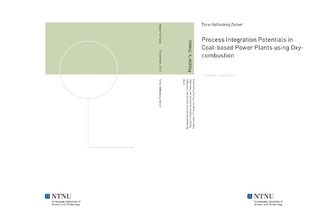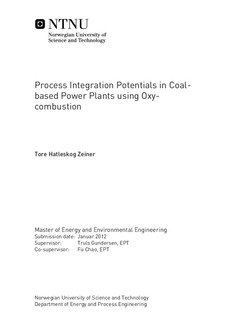| dc.description.abstract | Oxy-combustion is a promising technology for capturing CO2 from coal based power plants. In a coal based oxy-combustion power plant coal is combusted with high purity oxygen in order to produce steam for power production. The flue gas from this combustion consists mainly of H2O and CO2, but it will also be polluted with other components due to in-leakage of air, impurities in the coal, excess oxygen in the combustion and diluted oxygen supply. The main separation processes in such a power plant takes place in an air separation unit (ASU) where oxygen is separated from nitrogen, and in the compression and purification unit (CPU) where the CO2 in the flue gas is separated from the H2O and the other pollutants and compressed for transportation and storage. The introduction of these two units causes an efficiency penalty to the power plant. In this master thesis it is studied if and how heat integration of low temperature heat can decrease the efficiency penalty related to the ASU and CPU. The base case power plant is a coal based oxy-combustion power plant with a 567MW net power output and a thermal efficiency 31,32%. The heat sources considered are the heat which is removed by intercoolers in the compressors in the ASU and CPU, and waste heat from the flue gas exiting the steam generator. It is also studied if lifting the temperature level of the compression heat by compressing adiabatically will increase the potential for heat integration. Three main cases are considered for integration; integrating compression heat and waste heat from the flue gas with the feedwater system in the steam cycle of the power plant, integrating compression heat or flue gas heat to increase preheat of the recycled flue gas and oxygen entering the combustion, and integrating waste heat from the flue gas with a CO2 Rankine Cycle. It was found that integration of compression heat with the feedwater can increase the thermal efficiency of the power plant by 1,19% if the compressors are operated with intercooling and 1,49% if adiabatic compression is utilized. If the flue gas heat is also integrated, the efficiency increases by 1,72% with intercooled compression and 1,96% with adiabatic compression. Utilizing flue gas heat to preheat the recycled flue gas and oxygen can give efficiency increases in the region of 0,3-0,7%. The same applies if compression heat is utilized for this preheating. Since the temperature level of the recycled flue gas and oxygen is low, it is not necessary to compress adiabatically. If the waste heat in the flue gas is integrated with a CO2 Rankine cycle, efficiency improvements in the region of 0,47 to 0,51% can be obtained. The integration projects discussed in this report will increase the complexity of the system and may increase equipment costs. It is necessary to do a more detailed analysis of the heat exchanger networks required to reach the energy targets and heat exchanger surface area requirements in order to properly estimate the costs and choose the optimal configuration for integration. However it is recommended that future studies focus on the use of adiabatic compression heat as it has been shown to give significant increases in efficiency. Whether or not to include the flue gas in the integration depends on whether or not it is cost-efficient to introduce corrosion resistant heat exchangers to cool it below the acidic dew point. | nb_NO |

